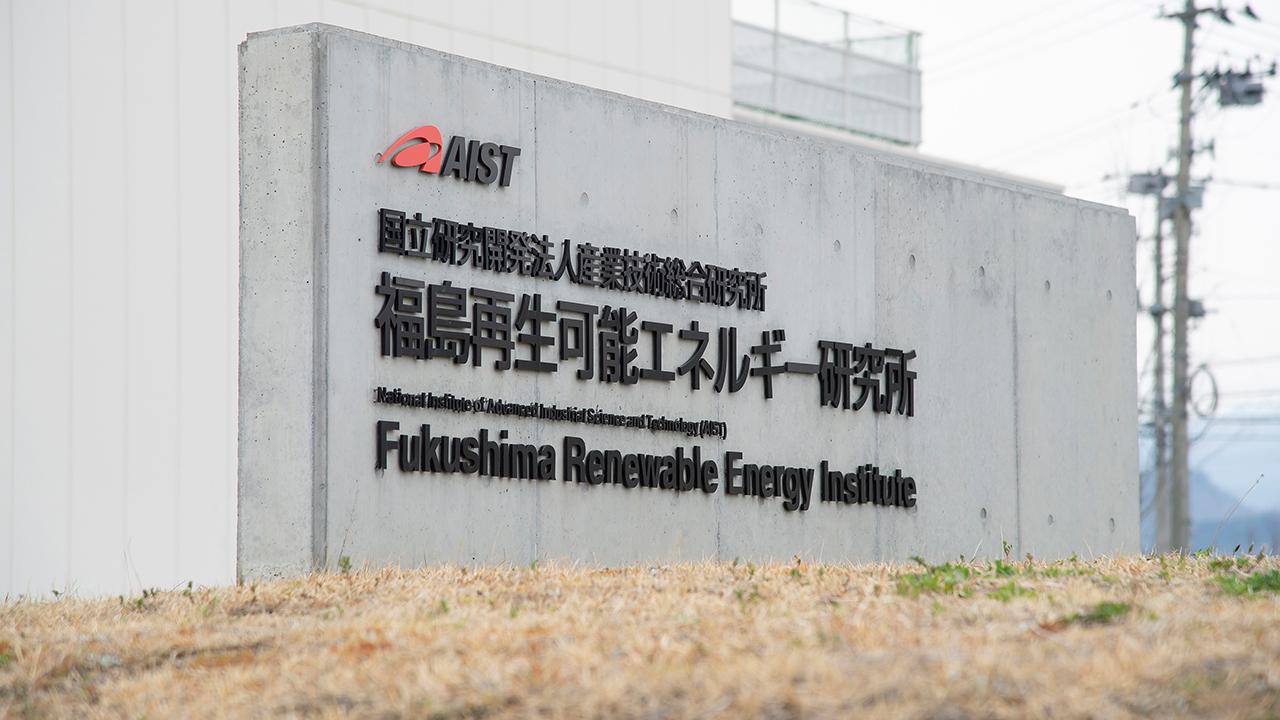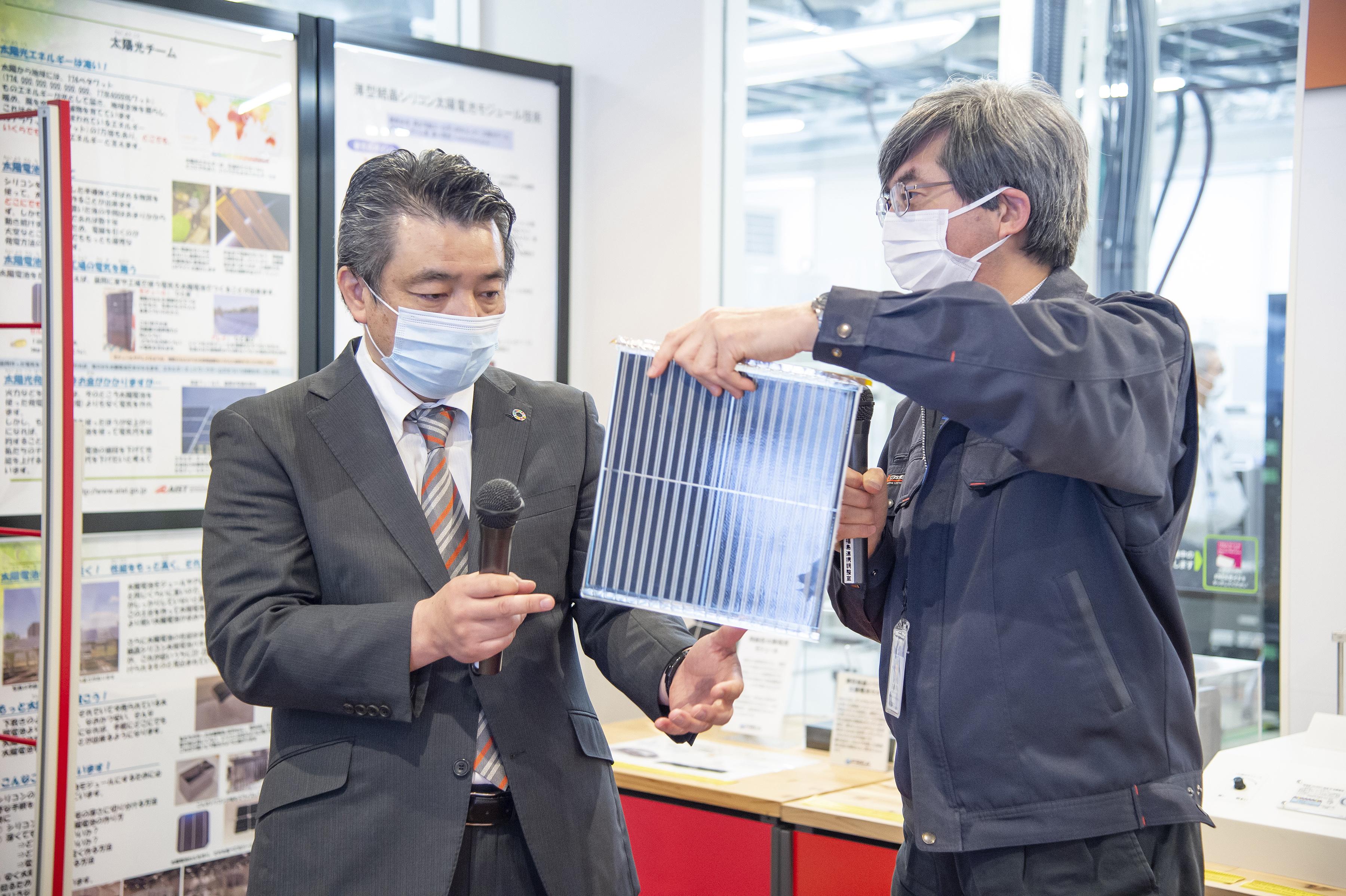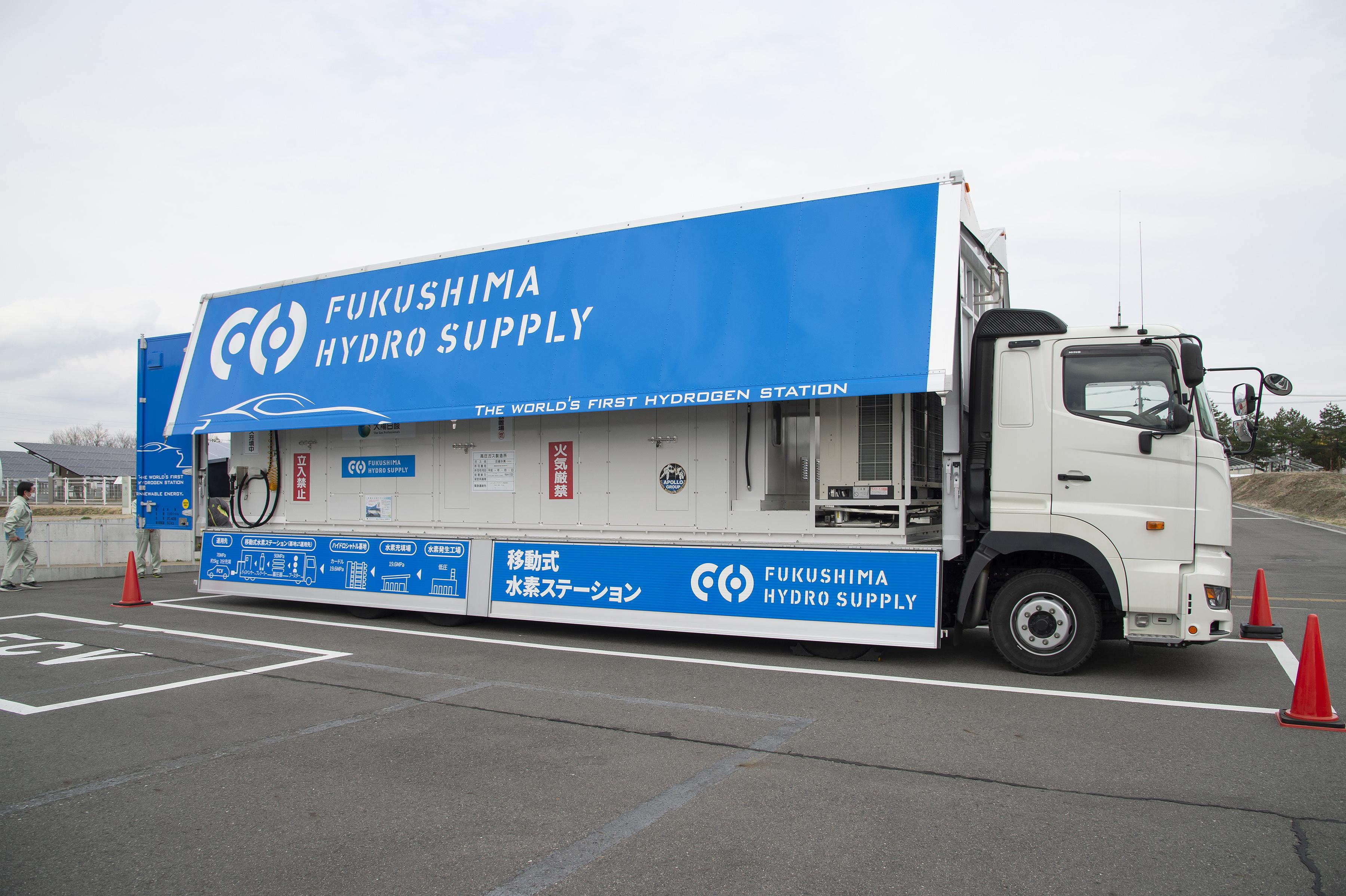
Masahiko Maeda, Toyota's Chief Technology Officer, visited a Fukushima-based research facility that works on cutting-edge renewable energy technologies. What were the findings and how will they be connected to Toyota's R&D in helping to achieve carbon neutrality?

On March 25, 2021, the Tokyo 2020 Olympic Torch Relay kicked off from Fukushima Prefecture. As the torch was carried through the town of Namie in Fukushima and also on other legs of the relay, hydrogen was used as the fuel to power the flame for the first time in Olympic Torch Relay history. This highlighted the Japanese government’s focus on the utilization of next-generation energy to people watching in Japan and around the world.

Like many countries around the world, Japan has announced its commitment to achieving carbon neutrality by 2050. This means that the net volume of CO2 emitted and the CO2 absorbed or removed must equal zero. The key to realizing such a target is hydrogen and renewable energy.
It is against this backdrop that Toyota’s Chief Technology Officer (CTO) Masahiko Maeda paid a visit to the Fukushima Renewable Energy Institute, AIST (FREA), Japan’s only national research institute engaging in work related to renewable energy. Toyota Times reporter Kyonosuke Morita reports on the visit.
Morita
Previously I reported on President Akio Toyoda’s visit to Fukushima Hydrogen Energy Research Field (FH2R) in Namie, Fukushima. It was this visit that provided me the first opportunity to give serious thought to “hydrogen.”
I learned that hydrogen compensates for the weaknesses of solar energy, and that the realization of a hydrogen society and the evolution of renewable energy technologies are inseparably intertwined.
Electricity from renewable energy sources is indispensable for the production of carbon-free hydrogen, and FREA, the destination for CTO Maeda’s visit, is an excellent location to learn about the current status of Japan’s renewable energy technologies.
Hydrogen, renewable energy, and carbon neutrality. I am covering Maeda’s visit with great expectations, looking keenly to see how “visits to consider the future of the Tohoku region” that began with Akio’s visit, can be linked to the development and realization of such things.

10 years on from the earthquake and tsunami: Moving from recovery to growth
The purpose of Maeda’s visit was to learn about the reality of and challenges for cutting-edge renewable energy research, with a view to further accelerate initiatives by industry and academia towards the goal of achieving carbon neutrality.
The energy cycle can be classified into three phases: generation, transportation and usage. Carbon neutrality cannot be realized unless CO2 emissions are reduced to zero not only in energy use in our daily lives, but also in all other phases of the energy cycle.
This is why it is incredibly important to consider energy policy and industry policy as a complete package, working hand-in-hand with research institutions because otherwise, carbon neutrality will remain a distant dream.
Many people in Fukushima and across the Tohoku region are even now still obliged to live as evacuees. Maeda made the following remarks before starting his tour of FREA:
Maeda
We stand here today 10 years on from the Great East Japan Earthquake. It is also a turning point as we look to switch from recovery to growth. We are already in contact and working together with you on a practical level, but if there is anything Toyota can do to work together with you to help Fukushima, the Tohoku region, and Japan, we would be very happy to move forward.

The visit was not just for the benefit of Toyota, but rather planned so that people in various positions in society could come together to accelerate initiatives. In addition to FREA members, there were also representatives from Fukushima Prefectural Government Office, and also Kazuhito Komuro, president of Netz Toyota Kooriyama Co., Ltd., a local car dealership.
A vehicle with fuel costs that are practically free
During his visit, Maeda asked researchers various questions about things that captured his interest.
As Maeda himself comes from a technical background, the interactions were quite technical. There seemed to be no end to his questions even while walking to a next stop, seeking to find any common ground between the research being undertaken at FREA and the initiatives being advanced by Toyota, and to identify ways to link the two.
Among all these questions, the most specific interaction concerned solar panels.
The solar panels being developed by FREA are capable of absorbing sunlight on both sides, both front and back, in order to generate electricity efficiently. This means that a solar power installation no longer needs to be limited to south-facing locations, greatly increasing the degree of freedom. Furthermore, the lightweight FREA system enables it to be installed in locations where it was not previously possible due to weight restrictions.
After hearing this, Maeda smiled at the accompanying reporters and said, “I’m concerned about the looks the reporters are giving us,” as he shared a specific image he had in mind.
Maeda
In the past, we placed solar panels on the roof of the Prius. However, it took time to fully charge.
In today’s vehicles the view from inside the back window can now be viewed using a camera and monitor screen, so it would be possible to install solar panels on the back window, too. If we could install your panels, which are capable of absorbing light on both sides, it would be possible to generate electricity efficiently from all directions on vehicles that frequently change course (while driving).
With these highly efficient solar panels, if you’re a person who doesn’t drive long distances, you could reduce your fuel bill to practically zero.

In the case of vehicle development, discussion often centers around images of what is considered to be a standard lifestyle, but for vehicles with a low operating rate the advantage of renewable energy is that fuel costs are not required. The way vehicles are used varies from customer to customer, so we need to think about how to use renewable energy to suit each individual’s lifestyle.
The challenge to installation of such devices has always been the cost. We are now in an era where we can realistically consider the balance between cost and efficiency.
The “story of the car with solar panels on the roof” Maeda mentioned presents a perspective that should not be overlooked when considering the expansion of research-based technology. At Toyota, it is often said that environmental technology can only have an impact if it is widely used. This is because if something is to be widely used, it is important for it to be easily understood by customers.
It is easy for anyone to confirm visually for themselves that the vehicle in front of them is fitted with solar panels, does not have a fuel cap, and therefore will not run up any fuel bills.
A pilot test is already underway using the buses of Fukushima Transportation, Inc., and a project being planned by Fukushima Prefecture also envisions a trial that installs solar batteries on battery electric vehicles (BEVs).
Instead of just collecting information in a one-sided manner, the group moved off to the next stop on the visit after discussing how to make use of renewable energy technology and the particular issues that are being faced.
Could renewable energy be likened to hybrid electric vehicles?
The next topic to be discussed was energy management to achieve maximum utilization of renewable energy.
As long as humans engage in activities, it is not realistic to expect that we can completely reduce CO2 emissions to zero. One of the goals that FREA is aiming to achieve is to make renewable energy the main energy source as a mean of reducing CO2 emissions.
However, the volume of power that can be generated from renewable energy sources such as solar and wind power depends on the time of day and weather patterns. This is why research continues to be advanced into methods that would enable a stable supply of electricity.
Hearing this, Maeda noted, “It’s a situation similar to hybrid electric vehicles (HEVs).” An HEV is capable of optimally controlling the balance between the engine and the motor in ever-changing conditions as the driver presses down or lets up the accelerator pedal. The similarity with renewable energy is therefore, “controlling and stabilizing something that fluctuates.”
Due to the similarity in thinking behind the two technologies, Maeda expressed hopes that if HEV researchers and renewable energy researchers could exchange technologies, they might be able to come up with some new ideas.



Discovering possibilities and encountering challenges
There was also a moment during the visit when Maeda found himself lost for words.
It was during discussions about simulations to ensure a stable supply of renewable energy.
FREA is implementing various simulations to facilitate the introduction of renewable energy into the existing energy network, through which it would be easy to manage supply, as is the case for thermal power generation. Through research activities, FREA continues to conduct simulations under many conditions, with the aim of gradually increasing the ratio of renewable energy.
Maeda was amazed by the ambitious scale of the project, then seemed to be perplexed, often lost for words. He responded the following as to why:
Morita
Although it was possible to identify various possibilities, you seemed to be at a loss for words at some points. Could you tell us your honest opinion about the outlook for the future that this research has opened up, and also about the tremendous work that still needs to be done?

Maeda
In order to make renewable energy a main power source, we need to think about how far we can raise the accuracy of our simulations.
What we want to know is what will happen if the energy network being researched is actually introduced in society. That is why it is necessary to verify in advance using a simulator. The next task is then to make sure that the answers we have verified are actually correct.
Without a great deal of verification data (for confirmation purposes), the accuracy of the simulation will not improve. The question is, on what level and on what scale should we expand the accuracy of the data?
In addition, we can expect that energy technology will continue a process of constant renewal along the way. Just thinking about the sheer scale of the challenge makes me faint. But if we don’t do it now, we will never be able to move forward.
When confronted with the difficulty of making renewable energy the main power source in a real urban environment, Maeda, with a slightly troubled smile, reconfirmed the importance of platform building.
Different regions have cities of differing sizes, each with diverse lifestyles. The volume of verification data available is still small, and many obstacles lie ahead for acquiring more data. That is precisely why Maeda has high hopes for the creation of a platform for renewable energy in a completely new place like “Woven City,” a prototype city of the future.
Energy saving will never spread widely unless it makes customers happy
Next on the itinerary was an introduction to research into wind power and ammonia, where visitors heard about the importance of energy saving.
In simple terms, the shortcut to carbon neutrality is finding a way to power our lives without energy that comes from fossil fuels as much as possible. In other words, energy saving. There are actually two energy saving methods as follows.
The first is “energy saving by not using.” This method is a simple matter of using less energy, but brings with it the possibility that sometimes this could come at the expense of consumer comfort.
Secondly, it is “energy saving through creativity in the ways we handle energy.” As with the solar panels mentioned earlier, boosting energy efficiency could be the way to save energy without burdening the consumer.
Maeda pointed out that when it comes to energy saving, unless the customers are happy, it will never spread widely. He went on to note that, “The simulations being researched here at FREA are very useful, and we need to promote energy saving as a package with technological development.” He then talked about the importance of dealing with energy saving based on an awareness of how it will be accepted by society.

More choices available means greater possibilities
The research currently being conducted by FREA will not lead to the reduction of CO2 emissions unless it is implemented and used. So, how can it be implemented? That depends on whether various needs of each region can be met.
It is important, therefore, not to rely on a single energy source, but to provide multiple options and allow customers to choose the best one for them. Renewable energy is just a single phrase, but it encompasses a range of different energy types, including solar, wind, and geothermal. There are also various ways to produce and use hydrogen.
The purpose of this visit was to explore all possibilities, and to find that FREA can also collaborate with companies like Toyota to bring their research to the wider world. Maeda was full of conviction when he stated the following;
Maeda
Rather than a one-issue solution, an energy mix (combining various types of energy) may become Japan’s strength, and, more importantly, it will enable us to offer all kinds of options to our customers. That is exactly why it is so important to prepare diverse energy choices.
As demonstrated by this visit, he also stated the importance of interacting face-to-face and exchanging opinions as follows:
Maeda
As President Toyoda himself is always saying, “It is the customer who decides.” However, the needs of customers change before you even realize it. Seeds (such as technologies and materials) are also steadily evolving. It is therefore vital to connect the needs of the world with the seeds.
As I have seen on this visit, it is important to go to the cutting edge to learn about the seeds, and to work to boost the probability of connecting needs with the seeds. It is also necessary to make the process as multifaceted as possible (incorporating a wide range of talents). It could be a very good idea to increase the number of Toyota engineers who come to FREA, which is conducting a diverse range of research activities for renewable energy.
I had wondered whether it would be possible to create some kind of matching application to connect the needs and seeds, but my feeling is that this would prove to be difficult. Explanation and a deeper understanding are required, so it is people who are the ones capable of providing such linkage. We need to further deepen the technical interaction between people in order to fully understand the needs and seeds and accelerate towards an endpoint together.
At Toyota we have a concept that, “Environmentally friendly vehicles can only truly have a significant positive impact if they are widely used.” In order to achieve wider use, it is imperative to increase options or risk not being chosen. This is why it is important to be able to connect advanced technologies to an endpoint (implementation) as quickly as possible.

Here, too, Toyota’s values of “genchi genbutsu" and being “human-centered” are alive and well.
It might sound better to push forward with a single goal in mind, concentrating on hydrogen, for example, in order to achieve the goal of carbon neutrality. However, in reality this seems not to be the case.
Contributing to carbon neutrality can take many forms. Maeda repeatedly underscored the need to keep all possibilities in mind. Energy diversity is the magnitude of possibilities towards achieving carbon neutrality.
It is possible that by 2050 the world will be overflowing with energy diversity, with the “right energy for the right place” being tailored to match the circumstances of each region. This visit made it clear that new technologies being created in Fukushima will provide the world a solid stepping stone to make progress from “recovery to growth.”
At the end of the visit, as he was making his way to the car park, Maeda came across a map of the Tohoku region in the reception area of FREA. He stopped by the map and shared his fond feelings for the region.

“I spent my university years in Sendai City in Miyagi Prefecture and would often come driving down to these roads, Hama-dori and Naka-dori. The seafood in this region is so delicious thanks to the minerals that are washed down from Mt. Zao.” It was with these parting word that he left FREA, driving a Prius PHV by himself.

